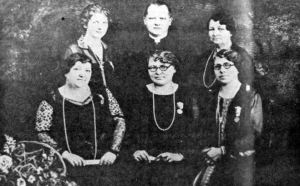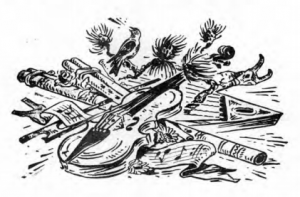Part IV: The Slovak Community of Cleveland
Cleveland Fraternals
The St. Stephen Society was started in Cleveland by Father Stephen Furdek, Andrej Sotak, and half a dozen other men on June 5, 1885. It had a twofold function — to collect dues and pay social insurance if a member fell ill and to foster a Catholic way of life. In order to bolster its financial resources, it affiliated with the already-existing Central Czech Union in 1889.
St. Joseph Society
Other fraternals that appeared in Cleveland remained in the Slovak camp, although religious differences divided them. On July 28, 1889, a group of religiously non-affiliated laymen founded a National Slovak Society and appealed to Catholics in the city to join it in an even wider union that, besides providing fraternal insurance, would work for national causes and downplay religion. Catholics, led by Father Furdek and Jakub Gruss, met with this society on May 5, 1890, listened to its leaders and decided that they were too anti-clerical. These Catholics then established the Society of St. Joseph which subsequently attracted church-goers into its ranks. This action foreshadowed the permanent splintering of the Slovak community along religious and secular lines. The secular fraternal adopted the name “Garfield” and joined, as branch number four, the newly-created non-denominational National Slovak Society of the United States of America headquartered in Pittsburgh.
The St. Joseph Society then led a group of other fraternals in founding the First Catholic Slovak Union in September 1890. As the moving force behind this venture, the St. Joseph Society made itself branch number one and established the national headquarters in Cleveland. Similarly, local Lutherans who had established their own Holy Trinity Society on February 14, 1892, helped form the Slovak Evangelical Union of the United States and became branch number three of this organization.
National Slovak Society
The national movement to unite Slovaks was begun in Pittsburgh in May of 1890. “The National Slovak Society of the United States of America” was the name chosen, and, by its name, it reveals a people who were aware of their national roots, but, who were just as aware of a desire to be true Americans. However, this is even more apparent in an examination of its constitution and bylaws of 1916:
Aims: “To educate the Slovak immigrants, who, being victims of unfavorable political conditions in their own country, were deprived of the means of education and culture; to make of its members all sons of their nation; to teach them to love their adopted country and to become useful citizens of this Republic; to help one another in sickness and distress and to help the widows and orphans when their breadwinners have passed away.”
Duties: “He must lead a moral life, make an honest living, and refrain from acts which would bring disgrace upon the National Slovak Society, and dishonor to the Slovak race. It shall be the duty of every member to become a citizen of the United States within six years after his admission to the Society. If he neglects to do so, a complaint shall be filed against him in the Supreme Court.”
First Catholic Slovak Union
While laudable in many ways (we especially enjoy the part where a complaint would be filed against anyone who did not become a citizen within six years), the Slovak Catholics of Cleveland under Father Stephen Furdek, finding the society too secular in nature and even anti-clerical, established another national society called the “First Catholic Slovak Union” which was to be considered Father Furdek’s single greatest achievement among the very many he accomplished. The membership was limited to Roman Catholics or Greek Catholics in good standing anywhere in the United States. The official organ Jednota (Union) was also started by Father Furdek and was edited in Cleveland by him continuously for the first ten years. While Cleveland still remains the national headquarters of the lodge, Jednota is now published in Middletown, Pennsylvania. It is interesting to note here that the “First Catholic Slovak Union” and its sister organization “First Catholic Slovak Ladies Union” make Cleveland the headquarters of the two largest Slovak organizations in the free world. (The national conference on Slovak ethnicity held in the 70’s in Cleveland under the sponsorship of the Slovak Leagye of America, focused the attention of Slovaks from allover the country on Cleveland.)
Today, the First Catholic Slovak Union has grown to over 115,000 members in 975 lodges located throughout the United States and Canada, with 40 of these lodges located in Cleveland. These are among its many activities up to and including recent times:
1. Made contributions in excess of six million dollars to enrich Catholic Slovak culture in America;
2. Supports the only Slovak Catholic Orphanage in the United States in Middletown, Pennsylvania;
3. Built the Chapel of Our Mother of Sorrows in the National Shrine of the Immaculate Conception in Washington, D.C.;
4. Maintains the Jednota Museum and Archives Institute which keeps historical records of the Slovak people; and
5. Made contributions to the building of SS. Cyril and Methodius Seminary in Rome where young men are trained to be priests so that one day they can serve Slovakia when it is free of Communism.
Slovak Gymnastic Sokol
To provide physical culture and training, the Slovak Gymanstic Sokol was established on July 4, 1896 in Perth Amboy, New Jersey. By 1918 there were chapters in New York, Massachusetts, Connecticut, Pennsylvania, Ohio, and Illinois. A similar organization limited to a Catholic membership called “The Roman and Greek Catholic Gymnastic Sokol Union” was organized in 1905. Both of these national organizations have chapters in Cleveland.
Slovak Women’s Fraternals
Slovak women also founded fraternals along secular or religious lines. The non-denominational “Zivena” of Pittsburgh established a branch (number four) in Cleveland in 1891 while Catholic women in 1892 banded together under Father Furdek and Anna Hruban to form the First Catholic Slovak Ladies Union with national headquarters in this city. By 1930 Cleveland had more than one hundred fraternals, most of them affiliated with larger national bodies and split on religious or non-denominational lines. The religious societies, however, enrolled the majority of Slovaks, whether locally or elsewhere.
The early fraternals led a very colorful, if disciplined, life. For former peasants it was honorific to be elected “president” or “secretary” of such an institution. They took their work seriously, presiding over weekly meetings as a judge might preside over court. The secretary, forced to keep clear and accurate minutes, not only improved his knowledge of Slovak grammar in America but also learned to write more elegantly. Orderly debate taught these men how to deal with the larger society around them, especially the political parties. Then too, the presence of a lodge “marshall” (bounder) led to respect for the decisions handed down by the officers and, hence, respect for the law.

Besides dealing with the normal lodge business of collecting dues and paying out insurance, fraternals also contributed to the social life of the community. They organized dances, balls, picnics, plays, singing societies, athletic events and bands. Many had their own colorful uniforms and on special Sundays would lead a parade around their church. They also enforced the observance of religious customs such as confessions and communion at Christmas and Easter, by fining any member who shirked his duty. Indeed, they often had reciprocal arrangements with other lodges (even those of another ethnic group) whereby members pledged to attend each other’s special functions and were fined if they did not. Such lodge activities went a long way in promoting strong group solidarity.

